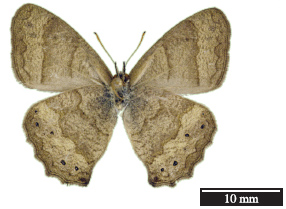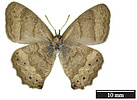Moneuptychia
Andrew V. Z. Brower- Moneuptychia melchiades
- Moneuptychia soter
- Moneuptychia itapeva
- Moneuptychia giffordi
Characteristics
Dias (2011) lists the following features that distinguish species of Moneuptychia from those of Carminda:
Outer margins of hindwings slightly wavy
Ventral hindwing medial line not extended and not angular
Ventral color pattern of fore- and hindwings similar
Male genitalia: uncus not laterally extended, latero-posterior apophyses of tegumen short and conical, angular appendices of tegumen present.
Discussion of Phylogenetic Relationships
Lamas (2004) considered Carminda Ebert & Dias 1997 to be a synonym of Moneuptychia, but Freitas (2007) points out that the phylogenetic analysis of Peña et al. (2006) shows members of "Moneuptychia" to be polyphyletic under that circumscription, with M. itapeva (misidentified as Yphthimoides sp.) more closely-related to Euptychioides and "M. paeon" more closely-related to Paryphthymoides. Dias (2011) has provided diagnostic features to separate species of Moneuptychia from those of Carminda.
References
Dias, MM. 2011. Taxonomic considerations on the genera Moneuptychia Forster and Carminda Dias, reval. (Lepidoptera, Nymphalidae, Satyrinae). Braz. J. Biol. 71, 537-540.
Freitas, AVL. 2007 A new species of Moneuptychia Forster (Lepidoptera: Satyrinae, Euptychiina) from the highlands of southeastern Brazil. Neotropical Entomology 36, 919-925.
Freitas, AVL,Emery, EO, and Mielke, OHH. 2010. A new species of Moneuptychia Forster (Lepidoptera: Satyrinae: Euptychiina) from central Brazil. Neotropical Entomology 39, 83-90.
Lamas, G. (ed.) 2004 Atlas of Neotropical Lepidoptera. Checklist: Part 4A Hesperioidea - Papiionoidea. Gainesville: Scientific Publishers/Association of Tropical Lepidoptera.
Peña, C., Wahlberg, N., Weingartner, E., Kodandaramaiah, U., Nylin, S., Freitas, AVL. & Brower, AVZ. 2006 Higher level phylogeny of Satyrinae butterflies (Lepidoptera: Nymphalidae) based on DNA sequence data. Mol. Phylogenet. Evol. 40, 29-49.
Title Illustrations

| Scientific Name | Moneuptychia soter |
|---|---|
| Location | Brazil: São Pauo, Rio Claro |
| Reference | Dias, M.M. 2011. Taxonomic considerations on the genera Moneuptychia Forster and Carminda Dias, reval. (Lepidoptera, Nymphalidae, Satyrinae). Braz. J. Biol. 71, 537-540. |
| Specimen Condition | Dead Specimen |
| Identified By | C. C. Dias |
| Sex | Male |
| Life Cycle Stage | adult |
| View | ventral |
| Collection | Universidade Federal de São Carlos |
| Collector | M. M. Dias |
| Source | Brazilian Journal of Biology |
| Image Use |
 This media file is licensed under the Creative Commons Attribution-NonCommercial License - Version 3.0. This media file is licensed under the Creative Commons Attribution-NonCommercial License - Version 3.0.
|
| Copyright | © 2011 M. M. Dias |
About This Page

Middle Tennessee State University, Murfreesboro, Tennessee, USA
Correspondence regarding this page should be directed to Andrew V. Z. Brower at
Page copyright © 2012
 Page: Tree of Life
Moneuptychia .
Authored by
Andrew V. Z. Brower.
The TEXT of this page is licensed under the
Creative Commons Attribution License - Version 3.0. Note that images and other media
featured on this page are each governed by their own license, and they may or may not be available
for reuse. Click on an image or a media link to access the media data window, which provides the
relevant licensing information. For the general terms and conditions of ToL material reuse and
redistribution, please see the Tree of Life Copyright
Policies.
Page: Tree of Life
Moneuptychia .
Authored by
Andrew V. Z. Brower.
The TEXT of this page is licensed under the
Creative Commons Attribution License - Version 3.0. Note that images and other media
featured on this page are each governed by their own license, and they may or may not be available
for reuse. Click on an image or a media link to access the media data window, which provides the
relevant licensing information. For the general terms and conditions of ToL material reuse and
redistribution, please see the Tree of Life Copyright
Policies.
- First online 01 November 2006
- Content changed 04 July 2012
Citing this page:
Brower, Andrew V. Z. 2012. Moneuptychia . Version 04 July 2012 (under construction). http://tolweb.org/Moneuptychia/83588/2012.07.04 in The Tree of Life Web Project, http://tolweb.org/








 Go to quick links
Go to quick search
Go to navigation for this section of the ToL site
Go to detailed links for the ToL site
Go to quick links
Go to quick search
Go to navigation for this section of the ToL site
Go to detailed links for the ToL site